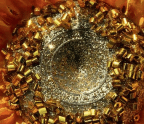
The designer Irma Boom’s work has garnered a long list of superlatives—she has been named creator of the “Most Beautiful Book in the World.” She is also the recipient of numerous prestigious design awards, and her books are part of the permanent collection of the Museum of Modern Art, New York. She has recently published Irma Boom: Book Manifest (Walther König, 2022), the third volume in an ongoing, iterative survey of her design work—an ever-evolving manifesto that she calls, informally and collectively, the “red book.” Each year, the book increases 3 percent in scale, whether a new volume is published or not. Book Manifest is not quite three inches tall; the first volume, published in 2010, was an inch and a half in height. Book Manifest contains a thousand pages stuffed with a selection of the more than 350 books Boom has designed to date and includes information gathered during her research in the Vatican Library on the history of the book as form. If Boom is the Queen of Books, she is a Philosopher Queen, one who is not only an instinctual maker but who has thought intensely about the nature and essence of the book.
Lesley A. Martin: Irma Boom, what a pleasure to see you. I’d like to start by talking about the materiality of a book, since a heightened consciousness of materiality is one earmark of your work. In Irma Boom: The Architecture of the Book (Lecturis, 2013), the second edition of the “red book,” Rem Koolhaas writes that you are a designer with the “stamina to wrestle material into submission.” How does the materiality of a book contribute to or support the contents?
: When I make a book, the first thing is to have a conversation with the person who wants to commission me—the photographer or the architect—and to talk about the project. Because I always want to find out if it’s necessary to make a book. Sometimes, it’s better as a website,? Because making a book is an enormous investment in time for all people involved. If we agree on making a book, then we talk about what it can be, should be, or what it wants to be. During that first conversation, I’m already making the book, basically. If I’m not making the book in my head, I should not do the project. It’s based on that first conversation. My brain begins to spin: What could it be? What could it be? The first idea I have is always the basis of the model; I start thinking of the size and then, maybe, about the materiality. It all goes together.






